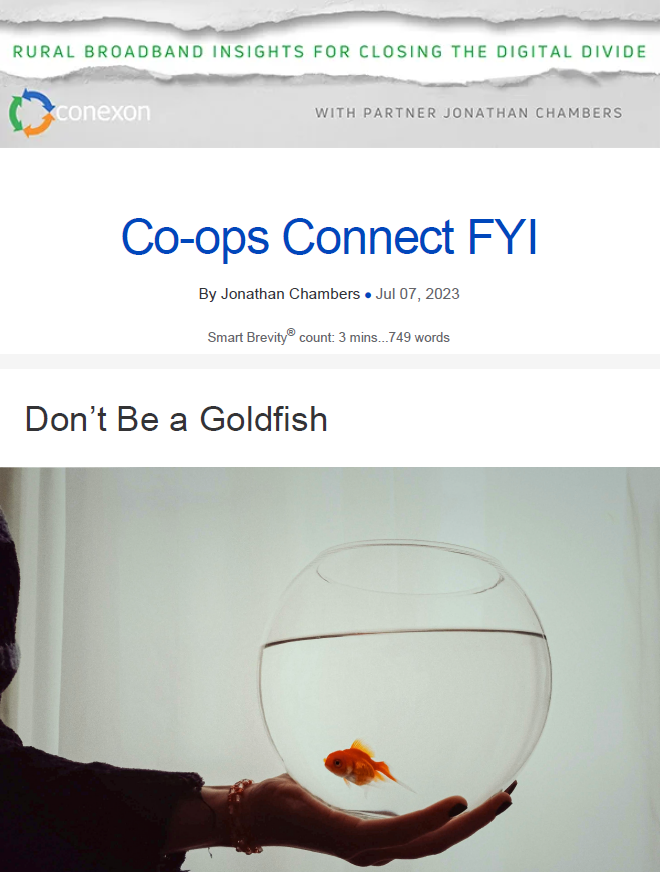Don't be a Goldfish
July 7, 2023
You know what the happiest animal on Earth is? It’s a goldfish. You know why? It’s got a 10-second memory.”
– Ted Lasso
Start with the basics:
- Goldfish actually do have memories longer than 10 seconds.
- It is difficult to imagine any species surviving with a 10-second memory. Darwin might have had something to say about that.
- As much as I enjoyed Ted Lasso and all his references to Kansas City, I think it is better to learn from past mistakes than to forget past mistakes.
What’s this got to do with broadband?
When it comes to telecommunications policy, the federal government has been a goldfish, happily making the same mistakes over and over.
- With last week’s announcement of BEAD allocations, it is a good time to remind state broadband offices and county officials of the federal government’s past mistakes. Learn from them.
- $42.45 billion is a lot of money. It is about the same amount of money the federal government spent on rural broadband over the past decade in the same places without closing the digital divide.
The bottom line:
There is a better way. For states and counties that want a different
result than the federal government, focus on:
1. Where
2. What
3. Who
Where Should BEAD Funds Be Spent?
Quit complaining about the maps and be smart about the use of the data instead.
- Nothing in BEAD requires that states use the FCC’s maps, not even the maps that were used to calculate the state allocations.
Yes, but: The FCC location and broadband data is valuable and can be used to produce an improved map of funding needs.
Start with the location fabric and modify the FCC’s broadband maps by making use of the technology type.
1. Obtain full use of the location fabric.
— The location fabric has been provided by the FCC to states but not counties.
— States are restricted in their use of the location fabric and should seek permission from NTIA to use the fabric for their BEAD programs.
— NTIA should allow use of the fabric for BEAD, including making the fabric available to the public in furtherance of BEAD programs.
2. Produce a more accurate broadband map by:
— Including all rural residences, businesses, and community
anchor institutions (such as churches, schools, and libraries).
— Considering as served only fiber-to-the-premise or cable broadband with DOCSIS 3.1. Everything else should be considered unserved or underserved.
— Removing for funding consideration only RDOF or ARPA areas where the winning bidder/awardee had committed to fiber- to-the-premise. Any RDOF area won by a fixed wireless company will be underserved. [See June 23 Co-ops Connect FYI.]
What Type of Network Should Be Funded?
Use BEAD for the broadband needs of the future, not just the present.
- Over the past decade, the federal government, adhering to the moronic shibboleth of technological neutrality, has repeatedly funded technologically inferior, out-of-date networks to provide 4/1 Mbps, 10/1 Mbps, 25/3 Mbps, 25/5 Mbps, 100/20 Mbps, and 1 Gbps/500 Mbps.
The bottom line:
Construction of any network less capable than multi-gigabit symmetrical services will be obsolete before the money is spent.
1. Broadband companies routinely announce new multi-gigabit symmetrical services.
— AT&T, Google Fiber, Lumen, and Conexon all provide multi- gigabit symmetrical service today.
2. Funding for anything inferior to that available in urban areas is a recipe for further waste.
— Section 254 of the Communications Act is clear that rural households should enjoy access to the same level of broadband service as urban households.
Who Should Receive BEAD Funds?
Broadband is large-scale infrastructure.
Only three types of companies build, or have built, large-scale wired infrastructure to the home:
1. Telephone/telecommunications companies
2. Cable television companies
3. Electric utilities
Who does it best?
Rural electric cooperatives — including their broadband subsidiaries and partners — consistently score markedly higher in consumer satisfaction than telecommunications or cable companies, according to the American Consumer Satisfaction Index.
Why? Ownership. The networks are owned by the members.
- The best use of public funds is an investment in networks owned by the people served, e.g., cooperatives.
How to go forward:
- Where there is an electric cooperative in your county, make the co-op part of the planning process. Even if the rural electric cooperative is not interested in becoming a broadband provider, it should be part of any rural county broadband plan.
- Where there is no electric cooperative, form a broadband cooperative.
The Big Picture
Better than a goldfish, be a butterfly.
Transform into something better.

